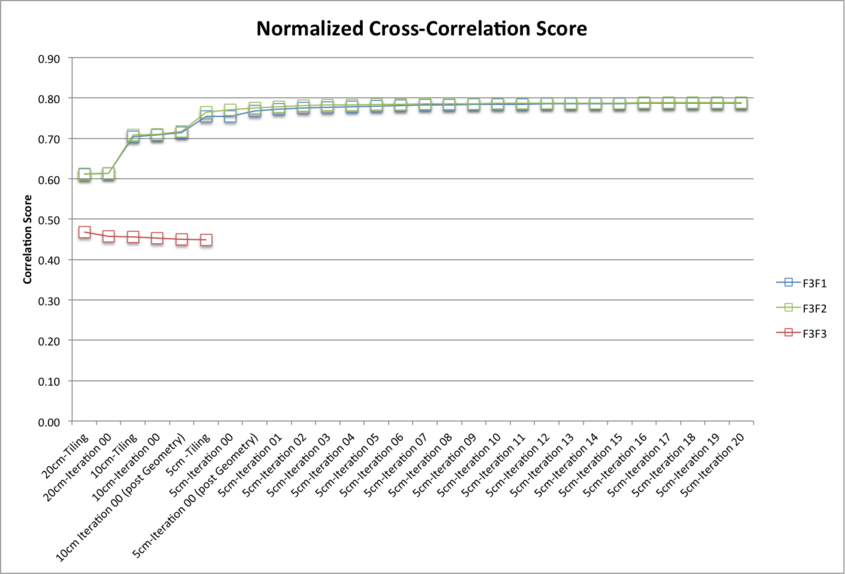|
Size: 3223
Comment:
|
Size: 3748
Comment:
|
| Deletions are marked like this. | Additions are marked like this. |
| Line 11: | Line 11: |
| Results from testing the three photometric functions split into two groups characterized by differing digital terrain accuracy and model behavior. Sub-tests F3F1 and F3F2 (Lommel-Seeliger photometric function without the 2 and with the 2 respectively) performed well with minor differences in the measurements of accuracy, whereas sub-test F3F3 (Clark and Tikir photometric function) performed poorly with pervasive degradation of the digital terrain with every processing step conducted. A detailed analysis of the behavior of F3F3 is reported here: [[Test F3F3 - Analysis]]. | Results from testing the three photometric functions split into two groups characterized by differing digital terrain accuracy and model behavior. Subtests F3F1 and F3F2 (Lommel-Seeliger photometric function without the 2 and with the 2 respectively) performed well with minor differences in the measurements of accuracy, whereas subtest F3F3 (Clark and Tikir photometric function) performed poorly with pervasive degradation of the digital terrain with every processing step conducted. A detailed analysis of the behavior of F3F3 is reported here: [[Test F3F3 - Analysis]]. |
| Line 21: | Line 21: |
The CompareOBJ RMS without translation or rotation is similar across subtests showing an inability to distinguish performance differences apparent from visual inspection of the evaluation maps, the normalized cross correlation scores, and the failure of F3F3 subtest at the 5cm tiling step. The CompareOBJ RMS with optimal translation and rotation is little better at distinguishing performance with some decrease in RMS of the poor-performing F3F3 subtest when compared with the well-performing F3F1 and F3F2 subtests. |
TestF3F Photometric Function Sensitivity Test Results
Definitions
CompareOBJ RMS: |
The root mean square of the distance from each bigmap pixel/line location to the nearest facet of the truth OBJ. |
Key Findings
Results and Discussion
Results from testing the three photometric functions split into two groups characterized by differing digital terrain accuracy and model behavior. Subtests F3F1 and F3F2 (Lommel-Seeliger photometric function without the 2 and with the 2 respectively) performed well with minor differences in the measurements of accuracy, whereas subtest F3F3 (Clark and Tikir photometric function) performed poorly with pervasive degradation of the digital terrain with every processing step conducted. A detailed analysis of the behavior of F3F3 is reported here: Test F3F3 - Analysis.
CompareOBJ RMS
Three CompareOBJ RMS values for the final 5cm resolution 20m x 20m evaluation bigmap are presented for each subtest and each S/C position and camera pointing uncertainty:
- The largest CompareOBJ RMS (approx. 65cm across subtests) is obtained by running CompareOBJ on the untranslated and unrotated evaluation model.
- The second smallest CompareOBJ RMS (approx. 15cm across subtests) is obtained by running CompareOBJ with its optimal translation and rotation option.
- The smallest CompareOBJ RMS (approx. 9cm across subtests) is obtained by manually translating the evaluation model and searching for a local CompareOBJ RMS minimum.
The CompareOBJ optimal translation routine is not optimized for the evaluation model scale (5cm pix/line resolution). Manual translations of the bigmap were therefore conducted in an attempt to find a minimum CompareOBJ RMS. The manually translated evaluation models gave the smallest CompareOBJ RMSs.
The CompareOBJ RMS without translation or rotation is similar across subtests showing an inability to distinguish performance differences apparent from visual inspection of the evaluation maps, the normalized cross correlation scores, and the failure of F3F3 subtest at the 5cm tiling step.
The CompareOBJ RMS with optimal translation and rotation is little better at distinguishing performance with some decrease in RMS of the poor-performing F3F3 subtest when compared with the well-performing F3F1 and F3F2 subtests.
Normalized Cross Correlation Scores
The evaluation maps were compared with a truth map via a cross-correlation routine which derives a correlation score. As a guide the following scores show perfect and excellent correlations:
- A map cross-correlated with itself will give a correlation score of approx. 1.0;
- Different sized maps sampled from the same truth (for example a 1,100 x 1,100 5cm sample map and a 1,000 x 1,000 5cm sample map) give a correlation score of approx. 0.8.
There is very little difference between the normalized cross correlation scores for the Lommel-Seeliger Photometric Function subtests (F3F1 and F3F2), both exhibiting very good correlation between the evaluation map and the truth map. The data however shows a poor correlation between the evaluation map and the truth map for the Clark and Tikir Photometric Function subtest (F3F3).

Correlation Scores:
|
Correlation Score |
||
Processing Step |
F3F1 (Lommel-Seeliger without the 2) |
F3F2 (Lommel-Seeliger with the 2) |
F3F3 (Clark and Tikir) |
20cm Iteration 00 |
0.6141 |
0.6133 |
0.4572 |
10cm Iteration 00 (post Geometry) |
0.7143 |
0.7168 |
0.4506 |
5cm Iteration 00 (post Geometry) |
0.7679 |
0.7756 |
|
5cm Iteration 10 |
0.7839 |
0.7564 |
|
5cm Iteration 20 |
0.7872 |
0.7884 |
|
